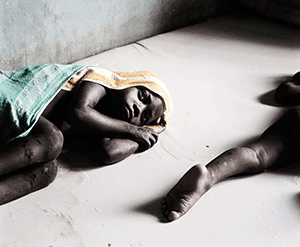For now, the mention of Ebola sends shivers down the spines of many Nigerians. However, Woman Editor, TEMITOPE DAVID-ADEGBOYE, writes that a familiar disease kills more than any other in Africa.
Since the first case of Ebola Virus Disease (EVB) through a Liberian-American, Patrick Sawyer, who later died within a few days, was reported in Nigeria, anxiety has continued to mount among Nigerians, with many wondering if the country could curtail the dreaded disease.
Within a month that this case was reported, the disease claimed five other lives, including that of Dr. Stella Adedevoh, the lead consultant at the First Consultant Medical Centre, Ikoyi, who prevented Sawyer from forcefully discharging himself.
These incidences have further heightened fears among people who hitherto had referred to HIV as the deadliest disease; with many saying Ebola is deadlier.
In the last one month, the news of Ebola has been on every social network, newspaper and television, and rightfully so. But there’s something deadlier than Ebola affecting Nigeria and Africans everyday: malaria.
While Ebola attacks its victims in a horrific manner, it is important to remember that it’s a relatively rare virus. Since it was discovered during two simultaneous outbreaks, in Sudan and the Democratic Republic of Congo (DRC), in 1976, there have been 25 separate Ebola outbreak incidents, all in Africa, totalling 2,895 deaths, according to the World Health Organisation (WHO).
On the other hand, the WHO estimates that in 2010 only, there were 219 million documented cases of malaria. That year, the disease killed between 660,000 and 1.2 million people, many of them children in Africa. The actual number of deaths is not known with certainty, as data are unavailable in many rural areas, and many cases are undocumented.
Malaria kills 3,000 children every day in Africa – that is, one million a year. It is on the increase, as war forces people to move out of their homes and the disease becomes resistant to the old drugs.
Head of the United States Agency for International Development (USAID), Jeremy Konyndyk, said during the week that poor understanding of Ebola was undermining the fight against the epidemic, pointing out that the fever is harder to get than malaria.
Ebola attacks its victims quickly. Symptoms, such as fever, weakness, diarrhoea and vomiting, generally occur eight to 10 days after exposure. Most patients recover or pass away within 10 days of symptoms appearing.
The USAID director in Liberia to support the fight against the epidemic which has claimed the lives of almost 1,500 West Africans stated that educating people on how to protect themselves was the best way to beat Ebola.
“Compared to something like malaria, it is much harder a disease to get. But obviously must worse when you do get it,” he said.
“So helping people to better understand how they can protect themselves, how they can avoid Ebola, is a critical piece of controlling this outbreak.”
Ebola transmission can be prevented by avoiding contact with an infected person’s bodily fluids.
On the other hand, malaria, spread through the bite of the Anopheles mosquito, often while the human host is asleep, is more difficult to avoid.
“One of the biggest challenges that we are faced with in this outbreak is misinformation or poor understanding. You know, Ebola is not a hard disease to avoid, if you know how to avoid it,” Konyndyk said.
Malaria is commonly associated with poverty and may also be a major hindrance to economic development.
While it appears that Nigeria is winning the war against Ebola, existing therapies are increasingly ineffective on malaria.
Chloroquine was introduced in the 1950s. When resistance to the drug developed in the 1970s, sulphadoxine-pyrimethamine (SP) was introduced. Resistance to these drugs is now so high in parts of Africa as to render them “virtually useless”, according to Medecins Sans Frontieres/Doctors Without Borders (MSF).
According to WHO, when the failure rate of drugs begins to register between five and 15 per cent, it should ring warning bells. When rates rise to between 16 and 24 per cent, a new drug regime needs to be initiated; but when failure rates reach 25 per cent and above, the drug regime needs to be changed. Failure rates for chloroquine are above 25 per cent in a majority of the malaria-affected countries of Africa, and the failure rate of SP is on the increase.
MSF points out in a recent report, ACT Now, that “ineffective drugs continue to be used despite the spectacular levels of resistance, leading to increased treatment failure”.
Chloroquine and SP continue to be used because they cost less than N200 per treatment, while Artemisinin combination treatment (ACT) costs almost N2,000 per treatment. MSF estimates this to be an annual cost of between N20,000 million and N400,000 million a year.
“Poor people who represent most of the continent’s malaria disease burden cannot afford to pay much more than what they currently pay for the old treatments, so costs must be subsidised by national governments with the help of international donors.
“What is missing is political will. Unless these changes, people will continue to die needlessly from taking drugs that no longer work,” the report adds.
Malaria does not invoke the same fear as Ebola, and certainly does not get the same media attention. But they are just as scary, and just as concerning.
Observers say if the government and people worked as tirelessly at preventing malaria attack as it has at preventing and treating Ebola, malaria could be eradicated or even become less common.













